In today’s economy, a college education is essential for getting a good job and entering the middle class. Yet, despite this reality, college costs are rising beyond the reach of many Virginians. State policy decisions have played a significant role in this rise by shifting costs onto students and families though declining state support. Virginia’s investment in higher education has decreased considerably over the past two decades, and its financial aid programs, though still some of the country’s most expansive, fail to reach many students with financial need. Students and their families now pay—or borrow—much more than they can afford to get a higher education, a trend which will have grave consequences for Virginia’s future economy.
The Great Cost Shift: How Higher Education Cuts Undermine The Future Middle Class.
This brief is based on the Demos report “The Great Cost Shift,” which examines how nationwide disinvestment in public higher education over the past two decades has shifted costs to students and their families. The report outlines how such disinvestment is magnified by rapidly rising enrollments, and its effects are felt particularly acutely as student bodies become more economically, racially, and ethnically diverse. This fact sheet focuses on Virginia, highlighting the trends in the state’s higher education funding over the last twenty years.
State Higher Education Funding Is Dramatically Declining
Virginia’s overall funding for higher education has declined precipitously since its pre-Great Recession peak in 2007. Funding per student in the state, consistently below the national average, has fallen even more dramatically, since enrollments have risen significantly even as total funding fell. Though state funding for higher education has historically risen and fallen in tune with the business cycle, the post-Great Recession decline appears to be a worrisome departure from the historical pattern.
- Overall, Virginia’s higher education funding fell from its peak of $2.07 billion in 2007 to $1.62 billion in 2013, a 21 percent decline.
- Funding per full-time equivalent (FTE) student has fallen 33 percent since 2007, and 44 percent since 2001.
- Because of this decline, Virginia’s funding per FTE student—$5,369 in 2012—is now the 16th lowest in the nation.
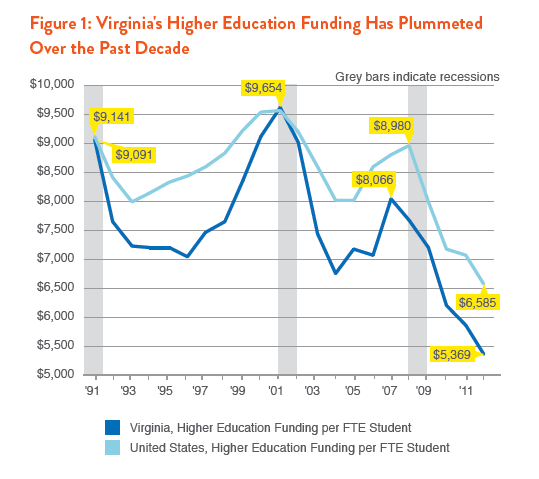
Skyrocketing Tuitions
Virginia’s declining state financial support for its public colleges and universities has translated into higher tuition and fees, making college increasingly unaffordable for the state’s students.
- Over the past two decades, average yearly tuition and fees at public four-year institutions in Virginia have risen by $4,851, a 108 percent increase.
- Tuition and fees have risen even more sharply at two-year institutions, rising 151 percent, or $2,304, over the same period.
- Tuition prices at both four- and two-year institutions in Virginia have been generally higher than the national average for the past two decades, a gap which has widened significantly over the past decade in particular.
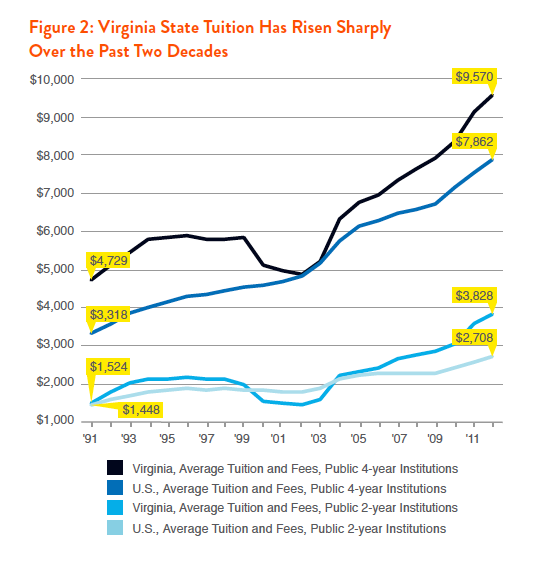
Grant Aid Has Become Somewhat More Generous
Despite the decline in overall higher education appropriations, funding for Virginia’s main grant financial aid program, the Virginia Commonwealth Award program has risen substantially since the Great Recession. The average grant awarded also rose slightly, helping to offset the rise in tuition costs for the approximately 16 percent of Virginia students who receive the grants.
- Total Virginia grant aid has risen by 69 percent since 2001, and by 17 percent since the Great Recession.
- The average award rose to $1,541 in 2013, 9 percent more than in 2001.
- However, despite this rise, the grants are paying for a sharply declining share of tuition costs: the average Commonwealth grant covered just 16 percent of average tuition at a four-year school in Virginia in 2013, down from 29 percent in 2001.
- The Commonwealth program benefits approximately 16 percent of all students, a share in the middle of the pack for state grant aid programs.
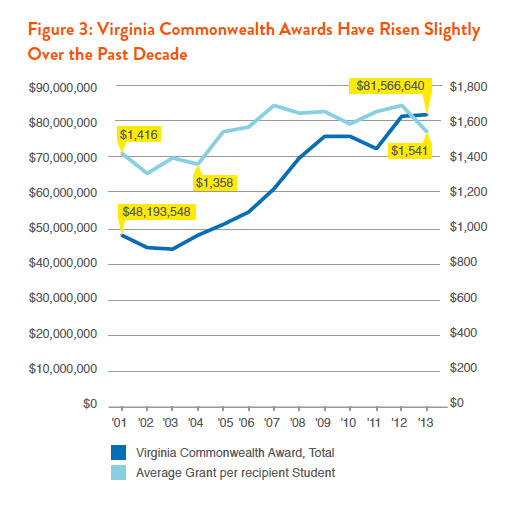
Shifting Costs To Students And Families
Tuitions have been rising far more rapidly than family incomes, causing the tuition costs to take an increasingly large bite out of family budgets. The increasing unaffordability of a college education in the state combined with the decreasing share of tuition covered by Commonwealth grants have forced Virginia’s students to borrow more to pay for school.
- In 2000, average tuition and fees alone at the average public four-year institution in Virginia cost 8 percent of a median household’s income; by 2012 this share had reached 15 percent.
- Fifty-seven percent of students graduating from public four-year colleges in Virginia in 2012 left with some student debt, a rise from the 54 percent who left indebted in 2004.
- The average debt of indebted graduates has risen precipitously. Indebted students graduated with an average of $25,329 in debt in 2012, a 35 percent rise since 2004.
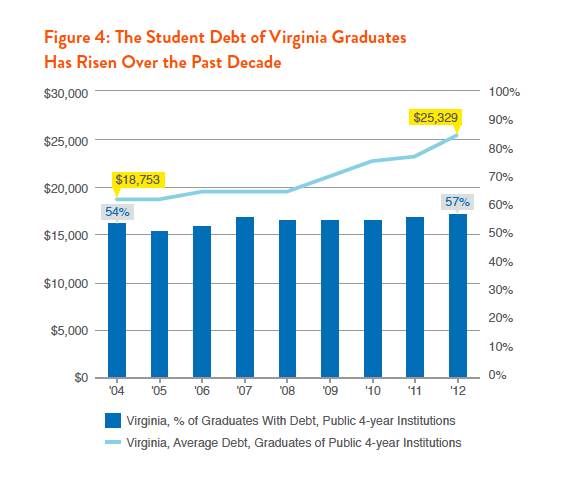
Increasing Enrollments, High Enrollment And Completion Rates
Despite the increasing cost of a higher education, enrollments at Virginia’s colleges and universities have risen steadily over the past two decades, in part due to the high share of Virginia’s high school graduates that enroll in college. Graduation rates at the state’s four-year schools, too, continue to outpace those of the country as a whole. However, one blot on Virginia’s higher education outcomes is its graduation rate from two-year institutions, which is below the national average.
- Total FTE enrollments at Virginia’s colleges and universities have risen steadily, increasing 55 percent from 202,285 FTE students in 1991 to 302,473 in 2012.
- Enrollments as a share of the young adult population have also risen, from 28 percent of all young adults enrolled in higher education in 1991 to 39 percent in 2012.
- Virginia has an average enrollment rate: 63.9 percent of Virginia’s high school graduates enrolled in higher education in 2010. This is the 23rd-highest share of any state in the country, just above the national average of 63 percent.
- The graduation rates at Virginia’s four-year colleges and universities are also above to the national average. As of 2010, 68.4 percent of students at the state’s public four-year institutions graduated within 6 years, a rate 13 percentage points above the national average and the fourth highest in the nation.
- However, the share of students at the state’s two-year institutions who graduated within 3 years was just 18.2 percent in 2010, 2 percentage points below the national average.
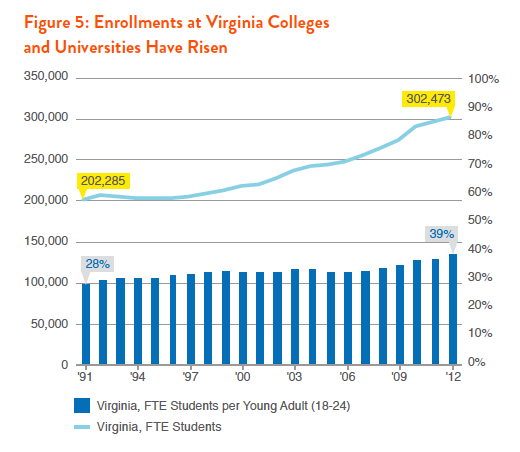
What Needs To Happen?
Even though Virginia’s graduation rate from four-year schools is higher than the national average, it is still too low to meet the future demands of the state’s labor market, which will increasingly require a postsecondary credential. Sixty-four percent of all jobs in the Old Dominion are projected to require some sort of postsecondary education by 2018, yet just 47 percent of young Virginians (ages 25-34) currently have an associate’s degree or higher. This share is not projected to improve much in the near future: by 2018, just 48 percent of all Virginians are projected to hold a two-year degree or higher, leaving the state with a significant educational gap in its labor market. Fortunately, Virginia can still close this projected gap by taking advantage of the state’s resources to invest in the current and future generations of Virginians aspiring to realize the American Dream through postsecondary education.
With the recent cuts in higher education funding, Virginia is endangering the quality of its institutions of higher learning, threatening the state’s economic competitiveness and the future of its young people. To reverse course, the state will need to commit to bold solutions that can strengthen and stabilize funding for Virginia’s state universities and colleges, and provide greater financial support to deserving students.